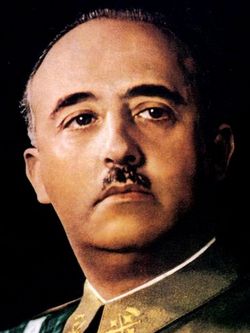
Cause of death: heart attack
163 cm
Francisco Franco Bahamonde (4 December 1892 – 20 November 1975) was a Spanish military general who led the Nationalist forces in overthrowing the Second Spanish Republic during the Spanish Civil War and thereafter ruled over Spain from 1939 to 1975 as a dictator, assuming the title Caudillo. This period in Spanish history, from the Nationalist victory to Franco's death, is commonly known as Francoist Spain or as the Francoist dictatorship.
Born in Ferrol, Galicia, into an upper-class military family, Franco served in the Spanish Army as a cadet in the Toledo Infantry Academy from 1907 to 1910. While serving in Morocco, he rose through the ranks to become a brigadier general in 1926 at age 33. Two years later, Franco became the director of the General Military Academy in Zaragoza. As a conservative and monarchist, Franco regretted the abolition of the monarchy and the establishment of the Second Republic in 1931, and was devastated by the closing of his academy; nevertheless, he continued his service in the Republican Army. His career was boosted after the right-wing CEDA and PRR won the 1933 election, empowering him to lead the suppression of the 1934 uprising in Asturias. Franco was briefly elevated to Chief of Army Staff before the 1936 election moved the leftist Popular Front into power, relegating him to the Canary Islands.
Initially reluctant, he joined the July 1936 military coup, which, after failing to take Spain, sparked the Spanish Civil War. During the war, he commanded Spain's African colonial army and later, following the deaths of much of the rebel leadership, became his faction's only leader, being appointed generalissimo and head of state in 1936. He consolidated all nationalist parties into the FET y de las JONS (creating a one-party state) and developed a cult of personality around his rule by founding the Movimiento Nacional. Three years later the Nationalists declared victory, which extended Franco's dictatorship over Spain through a period of repression of political opponents. His dictatorship's use of forced labour, concentration camps and executions led to between 30,000 and 50,000 deaths. Combined with wartime killings, this brings the death toll of the White Terror to between 100,000 and 200,000. During World War II, he maintained Spanish neutrality, but supported the Axis—in recompense to Italy and Germany for their support during the Civil War—damaging the country's international reputation in various ways.
During the start of the Cold War, Franco lifted Spain out of its mid-20th century economic depression through technocratic and economically liberal policies, presiding over a period of accelerated growth known as the "Spanish miracle". At the same time, his regime transitioned from a totalitarian state to an authoritarian one with limited pluralism. He became a leader in the anti-communist movement, garnering support from the West, particularly the United States. As the dictatorship relaxed its hard-line policies, Luis Carrero Blanco became Franco's éminence grise, whose role expanded after Franco began struggling with Parkinson's disease in the 1960s. In 1973, Franco resigned as prime minister—separated from the office of head of state since 1967—due to his advanced age and illness. Nevertheless, he remained in power as the head of state and as commander-in-chief. Franco died in 1975, aged 82, and was entombed in the Valle de los Caídos. He restored the monarchy in his final years, being succeeded by Juan Carlos, King of Spain, who led the Spanish transition to democracy.
The legacy of Franco in Spanish history remains controversial, as the nature of his dictatorship changed over time. His reign was marked by both brutal repression, with tens of thousands killed, and economic prosperity, which greatly improved the quality of life in Spain. His dictatorial style proved adaptable enough to allow social and economic reform, but still centred on highly centralised government, authoritarianism, nationalism, national Catholicism, anti-freemasonry and anti-communism.
Source : Wikipedia